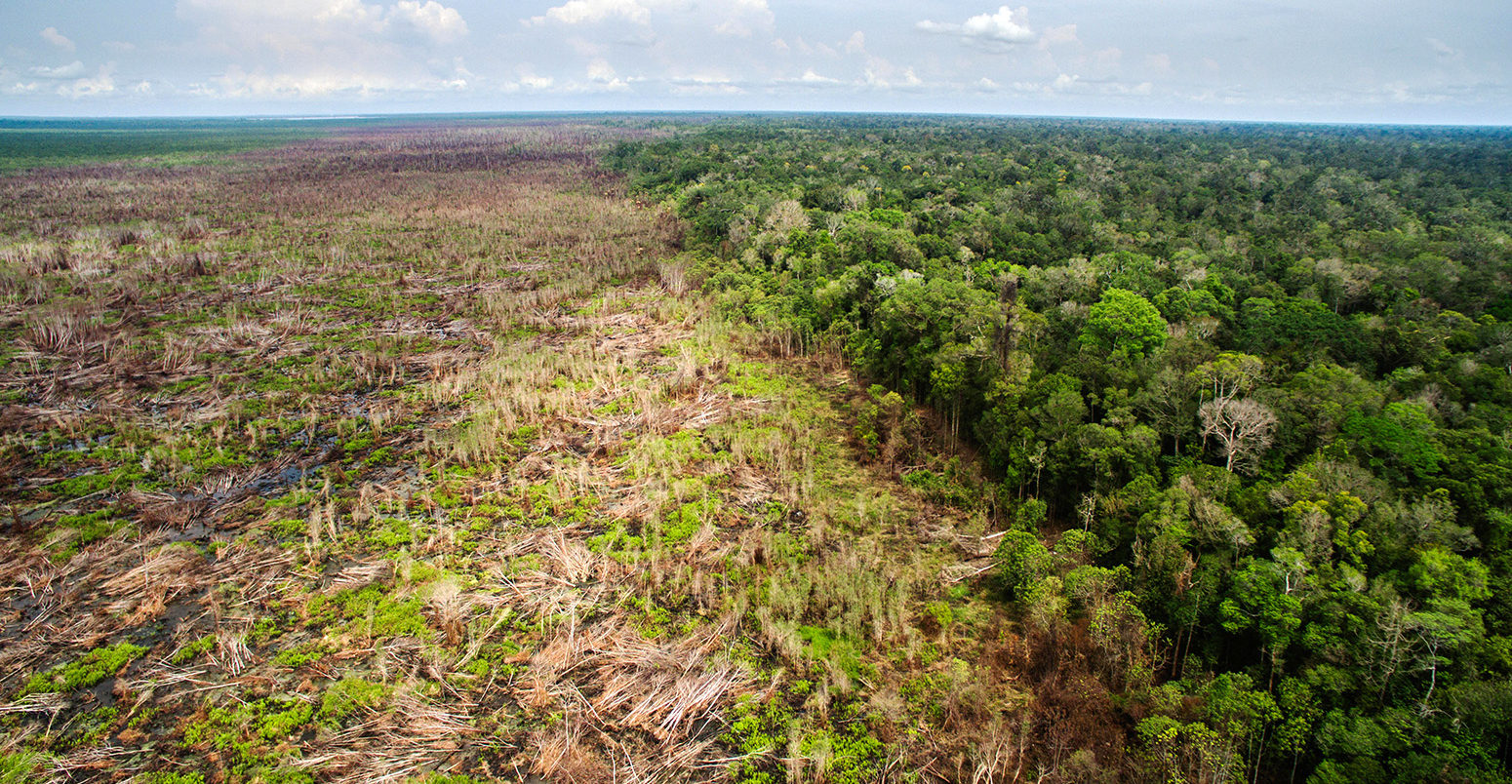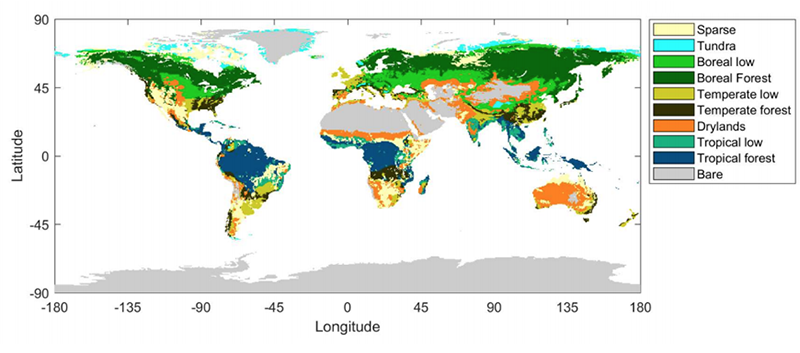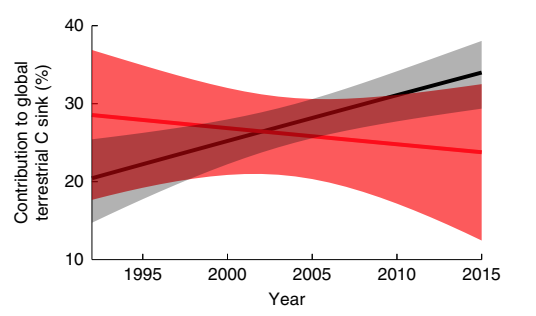
Tropical forests losing ability to absorb CO2, study says
Daisy Dunne
01.27.20Daisy Dunne
27.01.2020 | 4:00pmThe world’s tropical forests are losing their ability to remove CO2 from the atmosphere, while boreal forests are absorbing emissions at an increasingly fast rate, a study finds.
The new analysis uses a combination of remote-sensing data and modelling to create a detailed picture of carbon loss and gain across all of Earth’s biomes from 1992 to 2015.
It shows a diverging picture in the world’s two most important ecosystems for storing carbon on land: tropical rainforests and “boreal” forests, which are found in the cold climate of the high latitudes.
The chief driver of carbon loss in tropical forests over the study period was deforestation. Particularly affected areas are likely to include the Amazon, Indonesia and southeastern Asia, the lead author tells Carbon Brief.
It is not fully clear what is driving carbon gains in boreal forests, another scientist tells Carbon Brief. However, one likely driver is the “CO2 fertilisation effect” – a term describing how increasing CO2 levels in the atmosphere can boost plant growth.
Overall, the findings paint a comprehensive picture of a “worrying” shift in the ability of tropical forests to absorb CO2 emissions, she adds.
Evergreen
Around 30% of the greenhouse gas emissions from human activity are absorbed by the land – making it an important “carbon sink”.
The land takes in CO2 from the atmosphere when trees and other types of vegetation carry out photosynthesis, the process where plants use CO2 to build new materials, such as shoots, roots and leaves. This means that, as long as plants are alive, they can act as long-term “sinks” of CO2.
The new study, published in Nature Ecology and Evolution, uses a host of techniques to create a detailed picture of carbon loss and gain from 1992 to 2015 across all of the world’s biomes, which include drylands, sparse land, tundra (an Arctic environment) and temperate, boreal and tropical regions.
(“Temperate” forests are found in moderate climates and are known for experiencing four seasons, while boreal forests are found in cooler high-latitude regions and are characterised by evergreen pines, spruces and larches.)
The map below shows the distribution of the various biomes included in the study. Temperate, boreal and tropical ecosystems are further broken down into “low” or “forest”. “Low” is used to indicate regions that are not covered by primary forest, but instead made up of grass, croplands, shrubland or savannah.

To analyse carbon storage in each region, the authors use a combination of modelling and remote-sensing data. This data comes from satellites that use microwaves to detect changes in “above-ground biomass” – a measure of all the living plant matter that covers the land’s surface, including branches, leaves, trunks and fallen foliage.
In line with previous research, the study finds that tropical and boreal forests are the most important biomes for storing carbon. Together, these two biomes accounted for more than half (53%) the carbon held by land over the study period.
However, these two regions are now showing “divergence” in their ability to store carbon, says Dr Torben Tagesson, study lead author and researcher at Lund University in Sweden. He tells Carbon Brief:
“This study gives us an insight in how this CO2 uptake is distributed across the world – and we show that the contribution of the tropical forests is substantially decreasing. At the same time, the contribution of boreal forests is increasing.”
Overall, the land carbon sink increased over the study period – largely as a result of the boreal forests absorbing more CO2, he adds. The study finds that the land sink grew by an additional 1bn tonnes of carbon from 1992-2015.
Tropical turmoil
The chart below gives a more in-depth picture of this divergence. It shows the contribution of boreal (black line) and tropical (red line) forests to the land carbon sink from 1992 to 2015.
The shaded areas show the margins of error. (The uncertainties are larger for tropical forests because they are more sensitive to individual drivers of carbon loss and gain, the authors say.)

The chart shows how tropical forests have likely gone from being the largest contributor to the land carbon sink to the second largest behind boreal forests.
The primary reason for this decline is deforestation in tropical regions, says Tagesson:
“We can clearly see that the anthropogenic land use and land cover change have a big impact for the contribution of tropical forests.”
It is worth noting that the study only looks at changes up until 2015 – and since then tropical deforestation has accelerated in many parts of the world, he adds.
Late last year deforestation of the Brazillian Amazon reached its highest level in a decade, while central and west Africa also saw a spike in forest loss.
A second study published today in Nature Sustainability finds that loss of “secondary forest” in the Brazillian Amazon more than doubled from 2008 to 2014 – causing the release of 2.6bn tonnes of carbon. (“Secondary forest” refers to forest that was replanted relatively recently.)
Carbon loss in tropical regions was also affected by “meteorological factors” such as droughts – which cause tree deaths and worsen the risk of wildfires, the study finds.
‘Plant food’
The reason why boreal forests are absorbing CO2 at an increasingly fast rate is more difficult to tease out, says Tagesson. The study finds that both land-use change and meteorological factors played “minor roles” in the observed increase in boreal carbon storage over the study period.
However, it is likely that the “CO2 fertilisation effect” is playing a role, he adds. Plants use CO2 in photosynthesis and, so, as humans emit more of it, it appears that plants are growing faster – and storing more carbon.
Though the CO2 fertilisation effect has boosted the ability of boreal forests to absorb CO2 over the study period, it is possible that this effect may slow down or even reverse, says Prof Anja Rammig, a researcher of land-surface interactions from the Technical University of Munich, who was not involved in the study. She tells Carbon Brief:
“The question is: How long will this carbon stay in forests? It could be that this carbon gets lost earlier because if trees are growing faster, they could die younger. If trees are dying younger, we could expect to see a completely reversed picture in 10 or 20 years.”
The new study is “very solid” and creates a “comprehensive picture” of how the land carbon sink is changing, she adds. “A real strength is the authors look at above-ground biomass, rather than just ‘greening’, which is often used in forestry studies.”
“Greening” is a top-down measurement of how much more green the land has become over time. It is often derived from satellites that can create high-resolution images.
On the other hand, above-ground biomass is a measure of all the living plant matter that covers the land’s surface. Because it takes into account all biomass, rather than making a top-down estimate, it can be seen as a more complete way of measuring forest carbon, she says.
The high-resolution tools used in the study make it “extremely novel”, agrees Prof Ranga Myneni, a researcher of climate-forest dynamics from Boston University, who was not involved in the research. He tells Carbon Brief:
“I think the value of this study is in being able to tease out contributions of different biomes to the land carbon sink and then look at the temporal dynamics of those contributions, principally in the case of tropical and boreal forests.”
Tagesson et al. (2020) Recent divergence in the contributions of tropical and boreal forests to the terrestrial carbon sink, Nature Ecology & Evolution, https://www.nature.com/articles/s41559-019-1090-0
-
Tropical forests losing ability to absorb CO2, study says
-
High-latitude forests overtake tropics for carbon storage, study says

